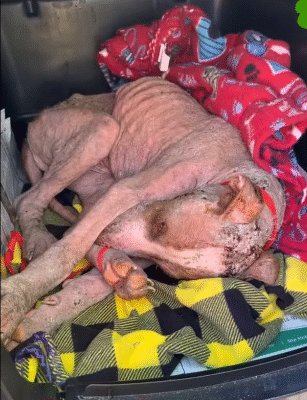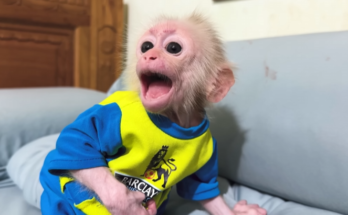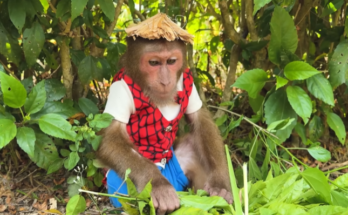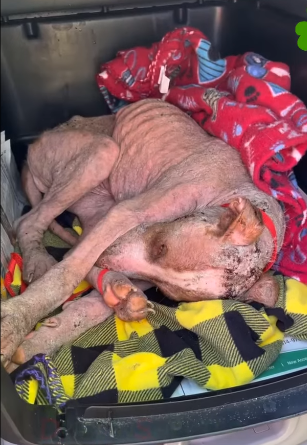
The first time they found Magnus, he was nothing more than a fragile whisper of what a living being should be. His ribs showed through torn, muddy fur, his eyes sunken, his breath shallow and broken. The people who passed him by thought he wouldn’t make it through the night. He was just a stray—skin and bones, discarded and forgotten on the edge of a quiet road where no one ever stopped.
But fate had other plans.
It was raining that evening when Sarah drove down that road, heading home from another long day at the animal shelter. She was tired, hungry, and ready to collapse into bed. But something—a flicker of movement by the roadside—caught her attention. She slowed down, headlights cutting through the mist, and saw him.
He was lying in a ditch, too weak to lift his head, his thin body trembling. Sarah’s heart clenched. Without hesitation, she pulled over, threw her coat over him, and whispered softly, “Hang on, buddy… you’re not dying here tonight.”
When she lifted him into her car, she could feel every bone in his body. His fur was matted, full of fleas and wounds. His eyes—those deep, amber eyes—met hers for just a moment. There was pain, yes, but also something else. A spark. A plea. A quiet will to survive.
That night marked the beginning of Magnus’s fight for life.
At the shelter, the vet shook his head. “He’s severely malnourished. Multiple infections. We’ll do what we can, but…” He didn’t finish the sentence. He didn’t have to.
Sarah stayed by Magnus’s side, refusing to give up. She named him Magnus, meaning “great” — because even in that broken, starving body, she saw greatness waiting to rise. She fed him with a syringe, cleaned his wounds, and whispered gentle words that he seemed to understand.
Days turned into weeks. There were moments when Magnus’s breathing slowed so much that Sarah thought he was gone. But every time, he found his way back. His spirit, though battered, refused to surrender.
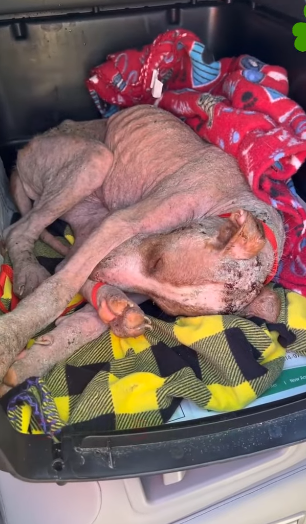
The first sign of hope came one quiet morning when Magnus, still weak and trembling, tried to stand. His legs wobbled like paper, but he pushed—again and again—until finally, for just a second, he was upright. Sarah cried tears of joy. “That’s it, Magnus! You’re fighting, baby! You’re fighting!”
From that day on, Magnus’s recovery became a miracle in motion.
Each sunrise brought tiny victories. He began to eat on his own, first a few bites, then whole bowls. His eyes brightened. His tail—once lifeless—started wagging again. The volunteers at the shelter gathered around his kennel each morning, cheering for the dog who had come back from the brink of death.
Sarah often sat with him after hours, talking to him as if he were human. “You know, Magnus,” she’d say softly, stroking his head, “people give up on life too easily. But not you. You’re teaching me what strength really looks like.”
By the third month, Magnus looked like a completely different dog. His coat had grown back glossy and golden, his muscles filled out, and his steps carried confidence. But the most amazing change wasn’t physical—it was emotional.
He had learned to trust again.
When Sarah entered his kennel, he no longer cowered or flinched. Instead, he pressed his head against her chest, breathing in her scent, as if reminding himself that love was real. Every time she hugged him, it was as though two broken souls were healing each other.
But Sarah’s journey wasn’t easy either. She had gone through her own storm—a recent divorce, the loss of her father, and the emptiness that followed. Taking care of Magnus gave her purpose again. He wasn’t just an animal she rescued—he became her reason to get up each morning.
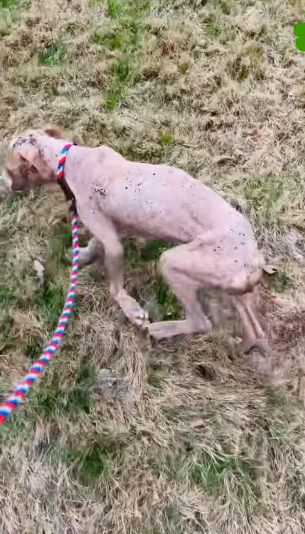
Soon, the shelter declared Magnus “ready for adoption.” Many people showed interest. He was beautiful, gentle, and had become a bit of a local hero after his story went viral online. But when one family came to claim him, Sarah couldn’t hold back her tears.
That night, as she sat alone in her car, she realized the truth—she couldn’t let him go. Magnus wasn’t just a rescue. He was home.
The next morning, she walked into the shelter, signed the papers, and officially made Magnus part of her family.
Their bond only deepened from there.
Sarah began taking Magnus on walks through the park, his tail high and proud. Children would run up to pet him, and he would lick their hands with pure joy. People who recognized him from the shelter’s posts would stop to say, “That’s Magnus! The miracle dog!” Sarah would smile proudly, replying, “Yes, that’s him—the strongest heart I’ve ever known.”
At home, Magnus became her shadow. He followed her everywhere—into the kitchen, the garden, and even waited outside the bathroom door. At night, he slept beside her bed, resting his head on her slippers as if afraid to lose her.
Then one evening, something magical happened.
While walking through the park, Magnus suddenly stopped and looked toward a man sitting alone on a bench. The man was sketching, his expression quiet and kind. Magnus tugged gently on the leash, pulling Sarah closer.
“Sorry,” she laughed. “He usually doesn’t do this.”
The man smiled. “No problem. He’s beautiful.” He extended his hand, and Magnus immediately licked it. “Friendly, too.”
His name was Ethan—a local artist who often sketched in the park for inspiration. They began to talk, discovering shared interests and a surprising sense of connection. Over the next few weeks, they kept running into each other, their conversations growing longer, their laughter warmer.
Magnus seemed to approve wholeheartedly. He’d wag his tail whenever Ethan appeared, often sitting between them like a proud matchmaker.
It wasn’t long before love blossomed—not the desperate kind born of loneliness, but the kind built on understanding and kindness. Ethan admired Sarah’s compassion, her strength, her resilience. And Sarah saw in him a gentleness that mirrored Magnus’s quiet courage.
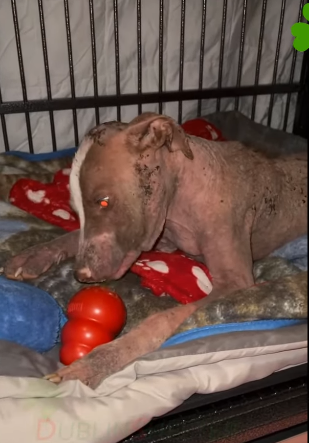
Together, they formed something extraordinary—a little family bound not by perfection, but by healing.
Years later, when Magnus grew older and his muzzle turned gray, he would lie by the fireplace, surrounded by warmth and love. Sarah often looked at him and whispered, “You saved me, you know.” Ethan would smile and add, “He saved both of us.”
Magnus’s eyes would close as if he understood every word. He had once been left to die, but now he was the beating heart of a home filled with laughter, art, and second chances.
When the day finally came for him to rest, Sarah and Ethan were there, holding him close. Tears fell freely, but there was no pain—only gratitude.
“Thank you for teaching us how to live,” Sarah whispered.
Magnus took one final breath, peaceful and loved beyond measure.
In the weeks that followed, Sarah painted a mural on their living room wall—a portrait of Magnus standing strong beneath a bright sunrise. Underneath, she wrote the words:
“Left to die and nothing but skin and bones, but he fought his way back to life—and taught us how to love.”
Magnus’s story lived on, not just in their hearts but in the lives of every animal they rescued afterward. He became the spirit of hope for countless others who had been forgotten, a symbol that love can bring anyone—no matter how broken—back to life.
Because sometimes, the most miraculous journeys begin at the very edge of despair.
Magnus had been left to die, but through courage, compassion, and love, he rose again—stronger, braver, and forever remembered as the dog who taught the world that no one is ever too broken to be loved. ❤️
